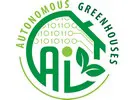While governments across the globe have introduced measures to limit the spread of COVID-19, the five teams participating in the Autonomous Greenhouse Challenge are hard at work to take autonomous and remote growing to the next level. The first remotely grown tomatoes have already been harvested. What's the current state of affairs, and how will autonomous cultivation develop further?
Digital future
With the current situation in the world, the Autonomous Greenhouse Challenge suddenly got a new dimension. Silke Hemming, who leads the Greenhouse Technology research team at Wageningen University & Research and organizes the challenge, also sees this.
"During times of limited access to buildings, greenhouses etc. such data projects become increasingly important, of course", she says. "I absolutely believe that remote growing and autonomous cultivation will be even more important in the future. I expect our society will change; digital solutions for communication with each other, but also to manage processes, will become more important and more appreciated. The Autonomous Greenhouse Challenge contributes to this. This makes it possible for a grower to get more information remotely, so at any point he has insight into his processes and can make adjustments accordingly. This way more/larger greenhouse compartments can be controlled, and a grower can make optimum use of his resources (energy, CO2 etc.) and thus save costs. On the other hand, he can realize optimum production and quality at the moments that it's needed."
Pushing the limits
In this year's edition of the challenge there's again 'at least 1 AI team' that's better than the reference. Why is that? "The teams are pushing the limits that growers don't dare to push or that they don't know exist", Silke says. The latest results show that the AI teams are keeping up quite well with the reference cultivation:
Autonomous Greenhouse Challenge: Also curious how teams are performing? See yield of cherry tomatoes. Seems that teams who started later catch up! At least 1 AI team is better than the reference!
— Autonomous Greenhouses International Challenge (@AutoGreenhouses) March 17, 2020
Thanks to our sponsors Tencent, Grodan, KPN, LetsGrow, Axia Seeds and Heliospectra. pic.twitter.com/P5vLubGuby
Not just robots
A lot can be done with AI and robots, but not everything. In the Autonomous Greenhouse Challenge, people are still needed in the greenhouse to carry out operations on the crops: potting, cutting, harvesting, etc. "In the current challenge, the focus is mainly on automating all the decisions, the focus is not on replacing all labor with robotization", Silke explains. This is, however, a very important additional step. We're now seeing with a) the tomato virus that it's becoming more difficult to keep a crop healthy and making sure people don't spread the virus, and b) that the coronavirus is making it more difficult to find people who can carry out such operations, with foreign workers leaving, etc."
Rapid development
At the WUR, they've been working on developing robotics solutions for 20 years now (see this page for examples). So far, however, labor was not too big of an issue because there were always seasonal workers available from other countries. In addition, labor costs were never quite high enough to warrant development of automated solutions. Besides, growers expect robots to do 100% of the work perfectly. Silke believes that the current developments encourage a different way of looking at these aspects, and that developments regarding robotics will be accelerated. "We need robotization solutions to reduce the dependence on human labor. This then makes it possible for boring tasks and work under challenging circumstances (high temperature and humidity, etc.) to be partly taken over by robots, or that robots can work together with people."
For more information: Autonomous Greenhouse Challenge
Autonomous Greenhouse Challenge
www.autonomousgreenhouses.com
